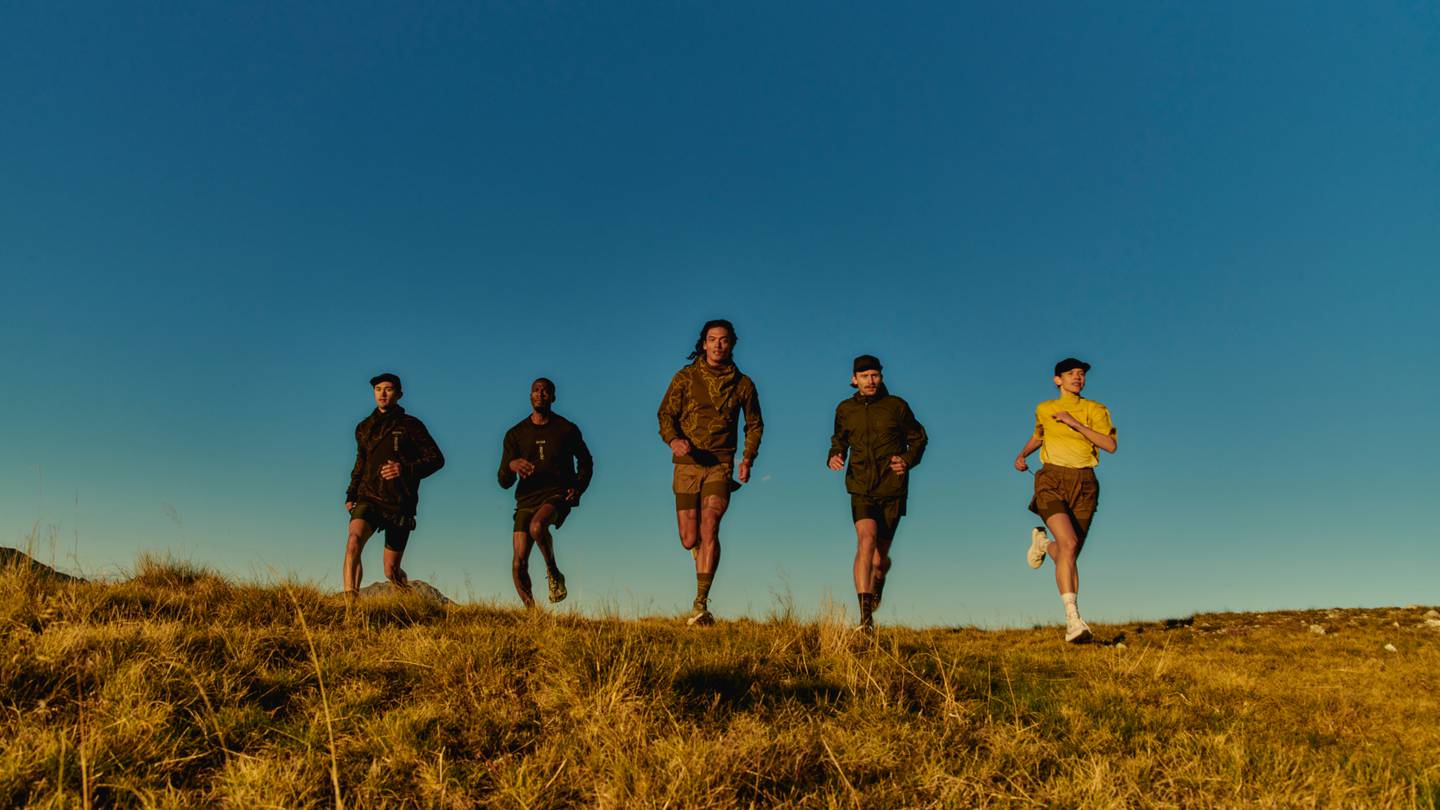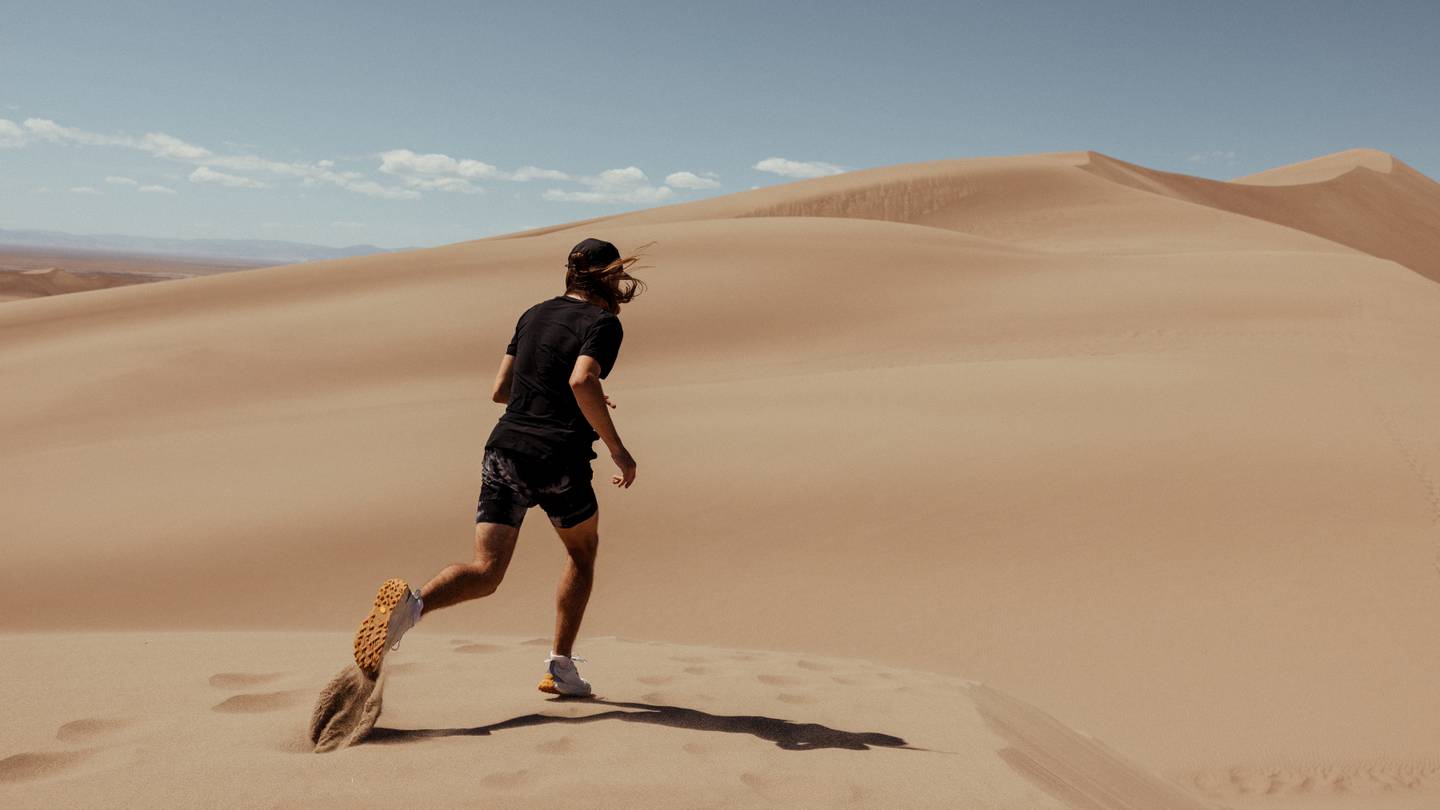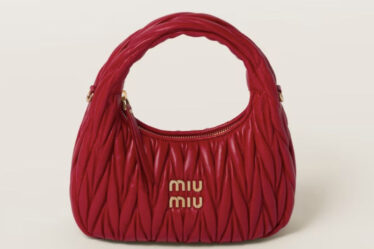
The $150 billion sports footwear market is veering off road.
Trail running, an endurance running sport which takes place on uneven terrain across hills, forests and mountains, is seeing its popularity soar. In 2022, global participation grew by 106 percent compared to the year before, according to World Athletics. The specialised footwear needed to withstand the gruelling physical trial, accounts for a tiny but fast-growing segment of the performance footwear category.
While still very much a niche sport, megabrands and start-ups alike are betting on trail running to be activewear’s next big category.
Back in 2020, fashion industry veterans Willa and Nick Martire founded Norda to make an ultra-lightweight sneaker which looked good and performed well on dirt tracks (trail races can range from anywhere between five to over 160 kilometres long), said Nick, a former president of Authentic Brands Group and Canadian fashion group, Aldo.
The Norda 001 trail running shoe, designed in their home outside of Montreal, caused an instant buzz among running enthusiasts and fashion insiders when it launched in July 2021, hitting the shelves at Dover Street Market, Kith and Ssense.
Three months later, they received a surprise phone call from the Italian luxury house Ermenegildo Zegna, asking to work on a product collaboration.
Norda’s $210 trail shoes are now stocked in over 160 speciality running and fashion retailers worldwide, and in February, Zegna took a minority stake in the fledgling footwear brand. On Monday, the pair launched their first collaboration, a capsule comprising trail-inspired footwear designed by the former alongside outerwear designed by the Italian luxury menswear brand, to be sold at Zegna stores worldwide and at retailers including Harrods and Ssense.
Choosing not just to collaborate, but to invest in a small trail footwear brand operating in a tiny market niche was an interesting decision. The Italian luxury group is on a hot streak as it repositions itself as a luxury leisurewear brand, rather than a formalwear specialist. Its newfound presence in the outdoors and performance-wear categories is designed to further help the brand diversify its appeal amidst menswear’s casualisation.
The partnership will allow the company to access a consumer base focussed on the “luxury outdoors” category, Zegna’s artistic director, Alessandro Sartori, told BoF.
Tapping into a business at the forefront of the fast-growing trail category could also boost the group’s bottom line, in the long-term.
Trail footwear, clothing and accessories are beginning to drive meaningful sales for larger activewear brands like On and Asics as they scale their trail assortments and sign professional trail athletes as brand ambassadors.
Fashion brands and retailers are co-opting trail running’s gritty outdoor aesthetic through collaborations with specialist incumbents like Salomon and Merrell. Buzzy brands like Soar Running and Paris-based Satisfy are making fashion-forward trail apparel and accessories like breathable balaclavas and hydration vests to capitalise on the sport’s growing appeal among regular running and lifestyle consumers drawn to the durability and technical elements of trail products, such as water resistance, insulation and ultra-light materials like the Dyneema fabric used for the upper of Norda’s running shoes.
Meanwhile, the gorpcore-friendly outdoors aesthetic of trail products has led to attention from fashion consumers. Salomon’s recent evolution from a niche outdoors equipment brand to a sneaker powerhouse was predicated on the sudden popularity of its XT-6 model, the now-famous trail shoe worn by celebrities like Rihanna and Bella Hadid. TikTok has also helped to spread the aesthetic and wellness credentials of the sport: #trailrunning has over 400 million views on the platform.
“Whenever an activity gets hot, especially one drawing a wide-ranging demographic, product will follow,” said Tim Newcomb, a journalist and sports footwear specialist. “In the same way we have seen tennis and basketball impact footwear, trail is beginning to have a similar influence.”
A Merchandising Gold Mine
For Japanese sportswear giant Asics, trail accounts for one of its fastest growing performance categories in terms of sales, with an average annual growth rate of 10 percent over the last three years, according to Magdalena Gassebner, the brand’s product marketing specialist for trail. In 2018, trail inspired the first iteration of Asics’ most famous lifestyle sneaker collaboration, with menswear designer Kiko Kostadinov, which borrowed the upper of the “GEL-VENTURE 6″ trail shoe.
Since 2020, Asics has invested heavily in the category, adding new performance products and scaling its roster of sponsored trail athletes from six to 45 trail runners, adding the likes of 24-year-old rising star Sara Alonso.
Last week, Nike announced an expansion of its own trail category, introducing new footwear models like the “Nike Kiger 9″ and the water-resistant “Pegasus Trail 4 GORE-TEX”.
Swiss running brand On is also “dedicating more and more resources” to its trail category, said Annaleigh Hockaday, the brand’s global head of product, performance outdoor. After launching trail footwear in 2016, On will debut a head-to-toe apparel line for the sport this summer. “Trail accounts for a small but significant amount of On’s business — this segment is growing year-over-year and we plan to evolve and grow to cater to more trail users,” Hockaday said.
As participation in the sport increases, there are endless merchandising opportunities for brands with dedicated trail offerings like Nike, On and Asics, thanks to the range of equipment needed by participants. Due to the extreme nature of trail running competitions, many of which last for over 100 kilometeres and take place in sub-zero or sweltering temperatures, each race comes with a list of mandatory equipment, including hydration vests which allow runners to drink through a tube and store essential food and medical equipment, as well as breathable jackets, shorts, visors, thermals and sunglasses, depending on the conditions.
Alongside the growing popularity of trail running itself, Gassebner credits the adoption of trail products by regular runners and lifestyle consumers for the uptick in sales.
So too does Brice Partouche, founder of fast-growing luxury running brand Satisfy, which raised $2.5 million in late 2021 in a funding round led by public investment bank Bpifrance.

Over 70 percent of Satisfy’s clothing is made for trail competition use and is compliant with the industry-wide gold standard known as the UTMB, named after a famous trail race in the French Alps. These days, a growing portion of the brand’s sales comes from casual road runners who see the durability and quality of trail gear as worth the added investment, said Partouche. (A Satisfy windbreaker will set you back €390 ($419), for example, and the brand’s shorts cost €180 — far more than what consumers fork out for performance running gear at Nike or Adidas.)
Gorp-Friendly Gear
When Partouche founded Satisfy in 2015, he “made it a clear strategy to align ourselves with the fashion calendar,” hosting showrooms and group runs with buyers and friends of the brand during Paris Fashion Week Men’s each year, he said. The brand’s visually stimulating marketing campaigns, often shot mid-race in deserts and forests, feature many of the long-haired, tattooed, hipster ultrarunners that make up its community. Meanwhile, the popularity of trail products as fashion items has soared over the last few years as trends such as gorpcore-centred technical footwear and clothing.
It’s Satisfy’s fashion-forward take on the trail aesthetic, combined with its reputation for creating technologically advanced gear for experienced trail athletes, that has led the brand to be stocked at market-leading speciality running stores such as Glasgow’s Achilles Heel, as well as luxury fashion retailers like Browns, Mytheresa and Mr Porter.
“Trail culture is like skateboarding — even when you are not out practising the sport, people still want to display they are part of the community, by wearing trail shoes or the technical clothing,” Partouche told BoF.
Brands are betting that demand trail products will long outlive the trends like gorpcore which helped bring the niche sport into the wider fashion industry.
It’s no longer about the watch you own, it’s about what the sneakers on your feet say about you as a person.
Merrell, a 40-year-old Michigan-based hiking and trail footwear manufacturer, has become an unlikely in-the-know gorpcore favourite over the last two years, co-creating colourful iterations of its footwear with brands like Sweaty Betty, and recently launching a capsule collection in collaboration with celebrity stylist Jason Bolden.
“Performance is a lifestyle now,” said Nick Martire of Norda. “Particularly in menswear, it’s no longer about the watch you own, it’s about what the sneakers on your feet say about you as a person.”



